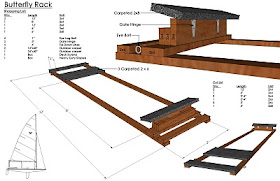Basic Mark Rounding Strategy
at 6.01.2008
Copyright (c) 2008 Doug Peckover
Boats converge at marks and present an excellent way to pick up (or lose) places. Here are some of the basics. Note that all of the strategy should happen before the 3 boat length circle as the rules change to favor the boat on the inside of a mark rounding.
 The first picture shows a common scenario where the boats have rounded a windward mark and do not jibe until the bottom mark. Green is ahead, is inside, has all rights, and is looking good. Red is thinking about going wide to dig inside at the mark. Are there better options? Definitely. Red can bear off sharply to get inside. If Green also bears off, Red can call “proper course” to force Green to head straight for the mark. Once Red is inside it has all rights and options as it will be going fast enough to establish an overlap.
The first picture shows a common scenario where the boats have rounded a windward mark and do not jibe until the bottom mark. Green is ahead, is inside, has all rights, and is looking good. Red is thinking about going wide to dig inside at the mark. Are there better options? Definitely. Red can bear off sharply to get inside. If Green also bears off, Red can call “proper course” to force Green to head straight for the mark. Once Red is inside it has all rights and options as it will be going fast enough to establish an overlap. How can Green defend against this? The key is anticipating Red before it makes its move. The simplest thing is Green pulling in its mainsheet to slow down. With an overlap, Red cannot bear off because it is the windward boat. Green slowing down is one of the few times when it pays to not to sail your fastest. In this case, Green should slow down enough to let Red get even or slightly ahead. This prevents Red from digging in, Green wants to make Red take the widest circle possible. Green should also consider jibing before the mark, being careful not to touch Red’s boom, to give Red more to think about when rounding.
 In this first scenario, the boat that anticipates best will come out ahead. In the second scenario, both boats have jibed and are on starboard. Things are very different here as Red has all of the options and should get inside to take Green’s wind and get an overlap.
In this first scenario, the boat that anticipates best will come out ahead. In the second scenario, both boats have jibed and are on starboard. Things are very different here as Red has all of the options and should get inside to take Green’s wind and get an overlap.Green’s best option is to anticipate this and head up and make eye contact. This sends the message “I’ll take you off the course if I have to.” This is a good move in fleets where Red is more likely to not waste time with just one boat. Alternatively, Green can let Red get and inside overlap and hope to get inside Red after the rounding.
Another option is Red being very aggressive by using its luffing rights outside 3 boat lengths, but luffing will waste many boat lengths to the fleet. But Green has a good defensive move that it can use.
 In this third scenario, Green has jibed onto starboard. This means that Green has all options outside three boat lengths, including heading up and forcing Red away from the mark. Green’s best move would be to slow down outside three boat lengths to force Red to take a wide rounding.
In this third scenario, Green has jibed onto starboard. This means that Green has all options outside three boat lengths, including heading up and forcing Red away from the mark. Green’s best move would be to slow down outside three boat lengths to force Red to take a wide rounding.Red has a few options but has to anticipate them well in advance. It could jibe and then exercise its rights in the first scenario. It could also bear off and hope that Green’s jibe mark rounding is wide enough to dig inside.
 This final scenario has Green jibing first after the top mark rounding. By doing so it makes itself vulnerable to Red which is still on starboard and can go hunting after Green. Green should either jibe back again or head up to get well clear of Red.
This final scenario has Green jibing first after the top mark rounding. By doing so it makes itself vulnerable to Red which is still on starboard and can go hunting after Green. Green should either jibe back again or head up to get well clear of Red.With an understanding of these basic strategies, it is possible to use mark rounding to gain significantly during a race.





